When it’s too Hot to Mow Your Lawn!
A healthy lawn provides you and your family with a green, lush and welcoming environment. However, when temperatures rise and the harsh summer sun beats down on your lawn, the ...

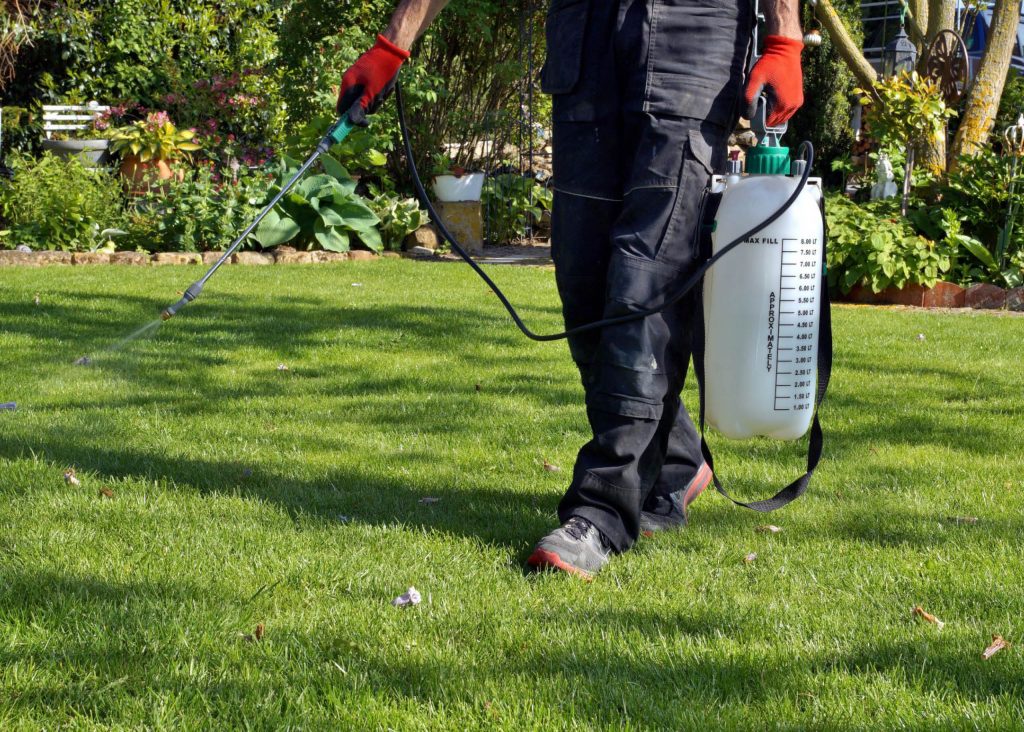 Herbicides are considered the most effective and efficient method of weed control for your lawn.
Herbicides are considered the most effective and efficient method of weed control for your lawn.
Knowing how and when to apply a herbicide correctly will give you the best result in maintaining a pristine lawn.
Generally speaking, there are two main groups of herbicides (post-emergent and pre-emergent), and within those groups, there are selective and non-selective herbicides.
Some weeds can only be controlled before they emerge from the soil, while others can be safely controlled after they are visible and established.
The most important thing to consider before undertaking any herbicide application is to correctly identify the weeds you are trying to control, and make sure the herbicide you need is safe to use on your lawn.
Always check the label of any selective herbicide to ensure it is safe to use on your turf variety, and check-in with your myhomeTURF specialist for expert advice.
Herbicides are classified based on several factors such as application, selectivity, persistence, action, and effect.
Herbicides exist in various forms (typically liquid or granular) that require different applications according to the way they are manufactured.
There are two types of selectivity:
Pre-emergent herbicides are used as a preventive measure to kill weeds before they have a chance to germinate. Their best time of application is before the growth of weeds. Pre-emergent herbicides are effective when applied at any time of day and create a chemical barrier in the soil that prevents weeds from appearing.
Pre-emergent herbicides have a long-lasting residual effect, typically remaining effective for around three to four months. They are best applied in early spring when weeds are most likely to germinate. The second application in mid-to-late summer may be necessary as the herbicide will slowly be washed out of the root-zone by summer rainfall, especially in Queensland and northern New South Wales.
Application timing is important for pre-emergent herbicides to prevent the weed seed from germinating. Once the weed has germinated (emerged), the pre-emergent herbicide will not stop the weed from growing.
Post-emergent herbicides work by targeting the vegetative parts of existing weeds, but they have no effect on seeds. This means that multiple applications of a post-emergent herbicide may be required to control a weed infestation. Each application of post-emergent herbicide will only kill the weeds that have germinated, and any that germinate after application will need to be sprayed again.
Post-emergent herbicides can be applied at any time of year when weeds are actively growing.
Selective post-emergent herbicides are most effective when applied to healthy and actively growing weeds. It’s best to avoid applying post-emergent herbicides during hot, dry, or frosty weather as this can make your lawn more susceptible to being damaged by a selective herbicide that is meant to be safe or, reducing how effective the herbicide is at controlling the weeds.
In spring and summer, early mornings within a few days of watering or rainfall with clear skies and cool calm weather will give you the best conditions to safely apply any post-emergent herbicide.
Important factors to consider before applying your herbicide treatment are:
Spring is the most effective time of year to apply selective herbicides for control of weeds before they can germinate and flower as the weather warms.
Some weeds that germinate heavily in spring, such as Summer Grass, Crabgrass and Crows Foot, are best controlled by a pre-emergent herbicide containing the active ingredient oxadiazon (Oxafert) or prodiamine (Spartan, Barricade).
Pre-emergent herbicides differ from post-emergent herbicides in that they need to water into the soil after application so that they are in the soil and in contact with the seeds.
Therefore, spring and summer are ideal times to apply pre-emergent herbicides before the rainfall that we typically see in Australia, otherwise, they can also be watered in by hand or irrigation.
Autumn is the next best time to apply herbicides as weeds can thrive on the sudden change in weather, and most lawns are less vigorous and more susceptible to weeds as the weather cools.
Herbicide spraying during autumn also means the weeds are less likely to flower and produce seeds, meaning you will have fewer weeds to worry about come spring.
Before applying any herbicide, carefully read and follow the label’s directions.
When applying liquid herbicides, potential spray drift problems can be avoided by following simple precautions.
To ensure adequate leaf surface and herbicide absorption, do not mow for three to four days before or after treatment.
To prevent a post-emergent herbicide from being washed off the plant’s foliage before it has been sufficiently absorbed, do not apply when rain is likely or water your lawn in the 24 hours following application.
Pre-emergent herbicides require a good amount of water shortly after application to ensure it is washed down into the soil and into the root zone where seeds are likely to germinate. Applying before rainfall or watering in after application is necessary to ensure good weed control.
Do not apply a post-emergent herbicide to a drought-stressed lawn or when air temperatures are higher than 30 degrees C, or the herbicide could damage the lawn.
ALWAYS make sure the herbicide you select is suitable for your lawn variety.
Most herbicides are available in a liquid form which is easy to apply using a suitable spray kit, however, some pre-emergent herbicides, such as Oxafert, are available in a granular form which can be spread using a fertiliser spreader.
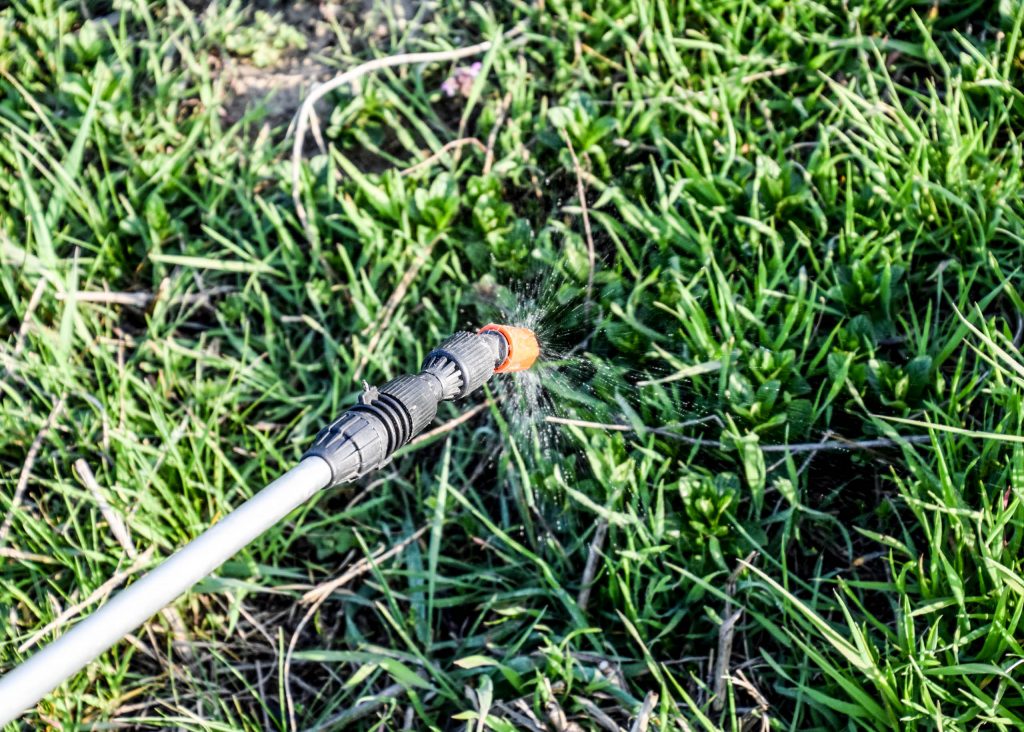 When spraying as a liquid, the herbicide is diluted with water at a specific rate (refer to the product label) and sprayed onto the leaf using a pressuring tank and spray nozzle to give even coverage on your lawn.
When spraying as a liquid, the herbicide is diluted with water at a specific rate (refer to the product label) and sprayed onto the leaf using a pressuring tank and spray nozzle to give even coverage on your lawn.
Advantages of using a spray are that it is quick and economical, and most herbicides are supplied as highly concentrated formulations that can last years for the average homeowner.
One of the limitations of spraying any herbicide is the potential for spray drift and off-target spray, so it is always important to make sure you spray using the correct equipment, droplet size, and only when weather conditions are suitable.
Foliar spraying can be performed in many ways, including:
It is a good idea to use a different sprayer for your selective and non-selective herbicides, as well as any other pesticides or fungicides to prevent cross contamination.
However, it is safe to use the same spray equipment for different chemicals provided the unit has been thoroughly cleaned and rinsed between applications (rinsing and flushing at least three times with clean water is recommended).
This method of application uses a wick or rope soaked in herbicide, which can be brushed carefully over the weed. This method is mostly used when applying a non-selective herbicide, such as glyphosate, directly to weeds in an established lawn. This method can be very economical as non-selective herbicides are typically much more affordable than selective herbicides, however, extreme care must be taken as any drips or splashed on your lawn or other plants will cause significant damage or death of non-target plants.
Hand or push spreaders are ideal for applying granular herbicides, such as Oxafert, over large areas.
Not many herbicides are available in a granular form, and while it is safe to use a fertiliser spreader to spread a granular herbicide, it is important to clean your equipment before and after use to prevent contamination between herbicides and fertilisers.
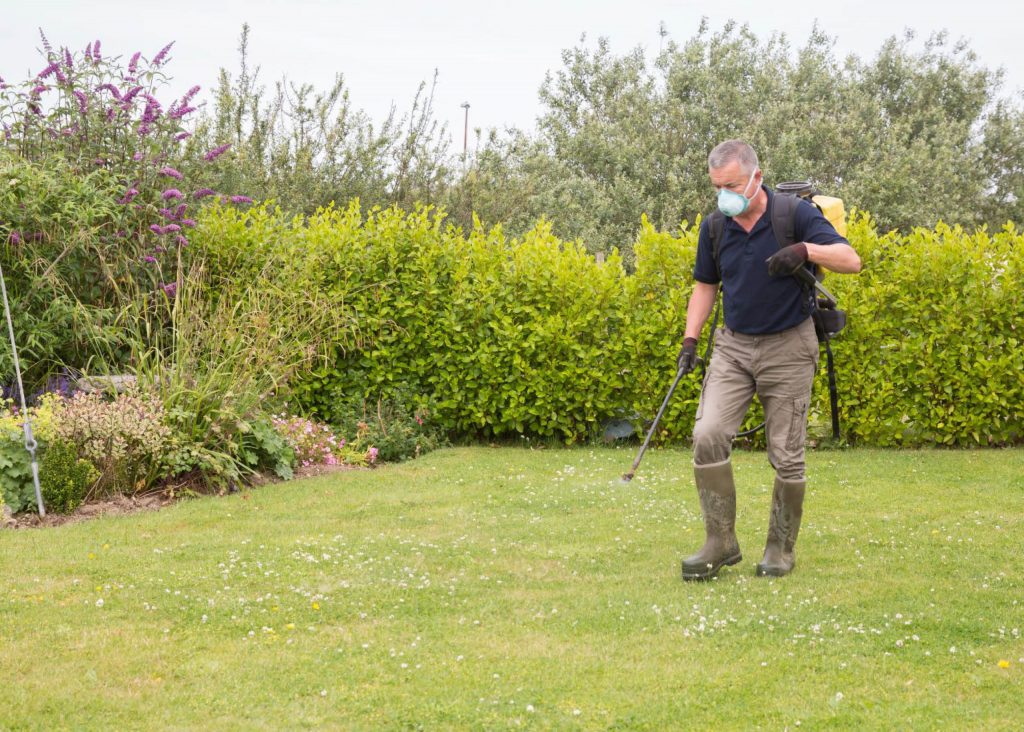 New lawns are more sensitive to herbicides than established lawns as they are still recovering and becoming established.
New lawns are more sensitive to herbicides than established lawns as they are still recovering and becoming established.
When the lawn has an established root system and has been mown at least four times it is safe to apply either a pre or post-emergent herbicide.
Pump sprayers (especially the cheaper ones) are notorious for leaking around the trigger or squeeze levers. Be careful of drips when applying herbicide and always wear gloves to be safe. Always repair or replace a leaking sprayer.
Herbicides are applied either as pre or post-emergence – meaning they are applied either before or after your lawn’s weeds emerge from the soil and begin to grow.
Pre-emergence herbicides kill weeds shortly after they germinate or emerge through the soil surface, while post-emergent herbicides are effective only once the weeds have germinated and are growing.
myhomeTURF’s online shop offers a large range of herbicides suitable for different lawns and weed problems.
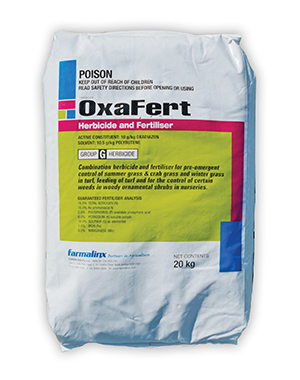
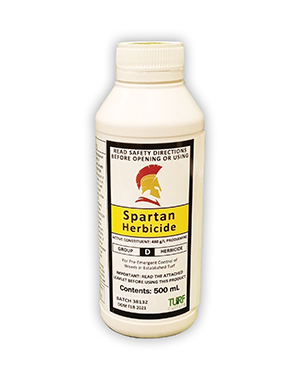
Spartan is one of the leading pre-emergent herbicides. Suitable for use on Zoysia, Kikuyu, Couch and Buffalo grasses. Always read the safety directions and instructions on the product label before use.
SHOP NOW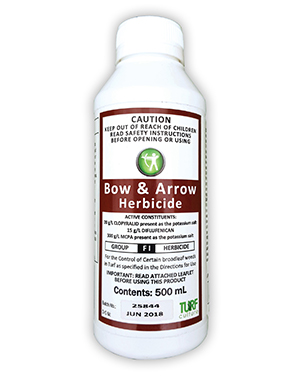
Bow and Arrow 500mL is one of the most effective broadleaf liquid herbicides on the market. Suitable for Zoysia, Kikuyu, Couch and Buffalo grasses however transient discolouration may occur on Kikuyu, Carpet and Queensland Blue Couch lawns. Always read the safety directions and instructions on the product label before use.
SHOP NOW